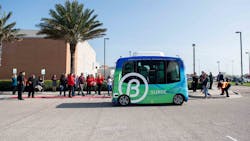NHTSA approves EasyMile to resume passenger operations in the U.S.
The National Highway Traffic Safety Administration (NHTSA) cleared EasyMile vehicles to operate in the United States following suspension after an autonomous shuttle made a sudden stop in Ohio earlier this year.
EasyMile worked with NHTSA to develop the Safety Passenger Enhancement Plan that the company says provides itself, as well as the wider autonomous shuttle industry in North America, with guidelines for all autonomous shuttles imported into the U.S.
“We’re excited about continuing to demonstrate and deliver the benefits of autonomous shuttles to the U.S. in the safest way possible, and in alignment with NHTSA,” said Sharad Agarwal, senior vice president of EasyMile Inc.
The company’s EZ10s are involved in demonstration projects in 16 U.S. cities and services will start up progressively as COVID-19 measures allow, and, as vehicle updates from the new plan are implemented.
The plan calls for an increase in awareness that sudden stops can happen for safety reasons, adding more signage, making audio announcements and enhancing safety operator training to remind passengers to hold on with feet firmly on the floor. EasyMile U.S.-based shuttles will also be equipped with seat belts.
The sudden stop incident in Ohio was determined to have occurred due to a slight deviation in the vehicles steering. Smart Columbus, which oversees the Linden LEAP service, where the sudden stop occurred, noted that while added precautions can be put in place and improvements made to reduce sudden stops, they can not be eliminated completely.
“We’re on the cusp of a transport revolution and these projects provide the opportunity for the community to be part of the journey and the learning process. To see the benefits and see the future,” said Agarwal. “We hope what comes out of this is an understanding of how safe and beneficial autonomous shuttles are to communities, and that it helps improve safety and service for all self-driving vehicles on the road in the future, and today.”
About the Author

Mischa Wanek-Libman
Group Editorial Director
Mischa Wanek-Libman is director of communications with Transdev North America. She has more than 20 years of experience working in the transportation industry covering construction projects, engineering challenges, transit and rail operations and best practices.
Wanek-Libman has held top editorial positions at freight rail and public transportation business-to-business publications including as editor-in-chief and editorial director of Mass Transit from 2018-2024. She has been recognized for editorial excellence through her individual work, as well as for collaborative content.
She is an active member of the American Public Transportation Association's Marketing and Communications Committee and served 14 years as a Board Observer on the National Railroad Construction and Maintenance Association (NRC) Board of Directors.
She is a graduate of Drake University in Des Moines, Iowa, where she earned a Bachelor of Arts degree in Journalism and Mass Communication.
